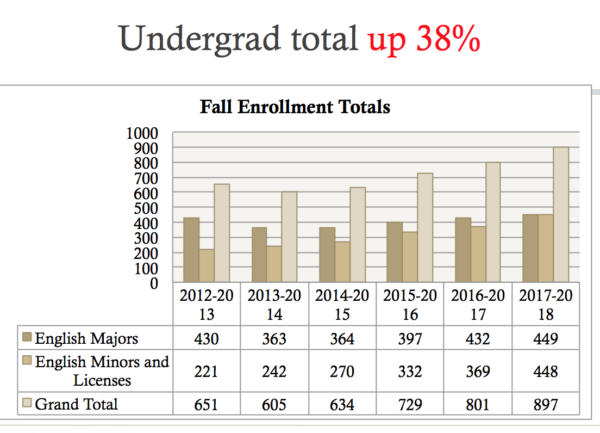There’s an alarming trend in higher education: the national decline in the number of students majoring in the humanities (an almost 9% drop in the last two years) and in English; the University of Maryland, for instance, has experienced a 40% decline in English majors in the last three years.
Holy crap, that’s a lot. And I’ve got to hand it to the leadership of that department for openly discussing the problem rather than trying to hide it. Sharing the steps they’ve taken to combat the problem with a national audience and with those in their discipline benefits us all.
But I want to brag for minute here, because I work in an English department that hasn’t been affected by these national trends. In fact, we’ve seen mostly growth (with a few dips).

How did this happen?
We made it easier to major and minor in English
- About 7 years ago, right around the time the economy tanked and higher ed started tightening its fiscal belt, we changed our major from 48 to 36 credits (except for the English Ed major, which is still 48), and we changed our minors from 21 to 15-18 credits.
- We (well, not me, I wasn’t here yet) responded to the university’s call to improve “time to graduation” proactively instead of reactively.
We have strong teachers in lower-level classes where recruitment happens
- Sometimes these teachers are TT faculty. More often, these teachers are what Ball State refers to as “contract faculty.” They are NTT positions, but the job comes with a 4/4 load, benefits, rank (Assistant Professor), and contract faculty are enfranchised, voting members of the department. Despite a recent raise, they are still not paid as much as they should be, but it is NOT adjunct work. We work very very hard not to hire adjuncts unless it’s an emergency.
- One of my biggest jobs in the department is making our master schedule–which is a hard thing for 33 TT, 37 NTT, and 40+ graduate students–and we do what we can to improve the quality of life for our contract faculty, such as scheduling them around their individual needs (travel from out of town, childcare, writing/research time, etc.) I can’t give them their first choice all the time, but my assistant and I try, and I think that this effort pays dividends that are both tangible and intangible.
- Many of them teach first-year writing, but we also work hard to give them a chance to vary that by scheduling them to teach in our Honors Program and giving those with MFAs a chance to teach creative writing and those with PhDs in Lit a chance to teach lower-level literature courses.
- I believe that there is nothing more important for your self-esteem and your professional identity than the ability to have at least some say in WHEN you teach and WHAT you teach. And if that makes people better teachers, and you have the resources to try and make it happen, why not do it? (I have a full-time assistant named Katie, without whom none of these things would happen.)
We introduced a concentration in creative writing.
- Rather than fight the explosion of interest in creative writing among college students, our department embraced it.
- Today, creative writing majors outnumber all the other concentrations, even English Education (a close second), but CW majors take a healthy dose of literature courses, which keeps our classes full to bursting.
- Notably, our CW major includes four genres: fiction and poetry, sure, but also creative nonfiction and best of all, screenwriting–important because Ball State is David Letterman’s alma mater and is very interested in all things visual, media, etc.
We introduced and marketed our highly appealing minors both inside and outside the department.
- Enrollment in all of our minors is way up! 138% overall in the past five years.
- Creative writing is a very popular minor for many majors. So is our Professional Writing and Emerging Media minor. So is our Film/Screenwriting minor.
- I think our new minor in TESOL will be very popular as well.
We are visible and have a lot of community IRL and online
- We don’t have a huge programming budget, like say Butler University. But we do have lively co-curricular programming that’s well attended by students all over campus.
- In the spring, that’s our In Print Festival of First Books (created by Jill Christman).
- We have the amazing Marilyn K. Cory speaker series, which brings people like Mahogany Browne and Tyehimba Jess to campus.
- We have a department blog and social media. We leveraged our work-study student secretaries to work on public relations when they aren’t answering phones or making copies.
- When I took over in 2014, I tried to grow our digital community so that students and faculty might feel more part of an IRL community. I talked about those initiatives here.
- And then in 2016, we created an immersive learning class, Jacket Copy Creative, our own in-house PR firm.
We address our students’ concerns about “What am I going to do with this degree?”
- We feature alumni success stories on our blog, which are then archived on our “Life After Ball State” webpage.
- For two years, we’ve sponsored a Career Week.
- Then we created the Stars to Steer By series that happens once a month.
- We’ve made it easier for our students to see the professional opportunities we offer.
The Future of the Liberal Arts
I really believe this: Ball State is a great place to study English and the humanities in general, because you get a great liberal arts foundation AND experiential-learning classes in your major that show you how to apply your skills in a real-world context.
